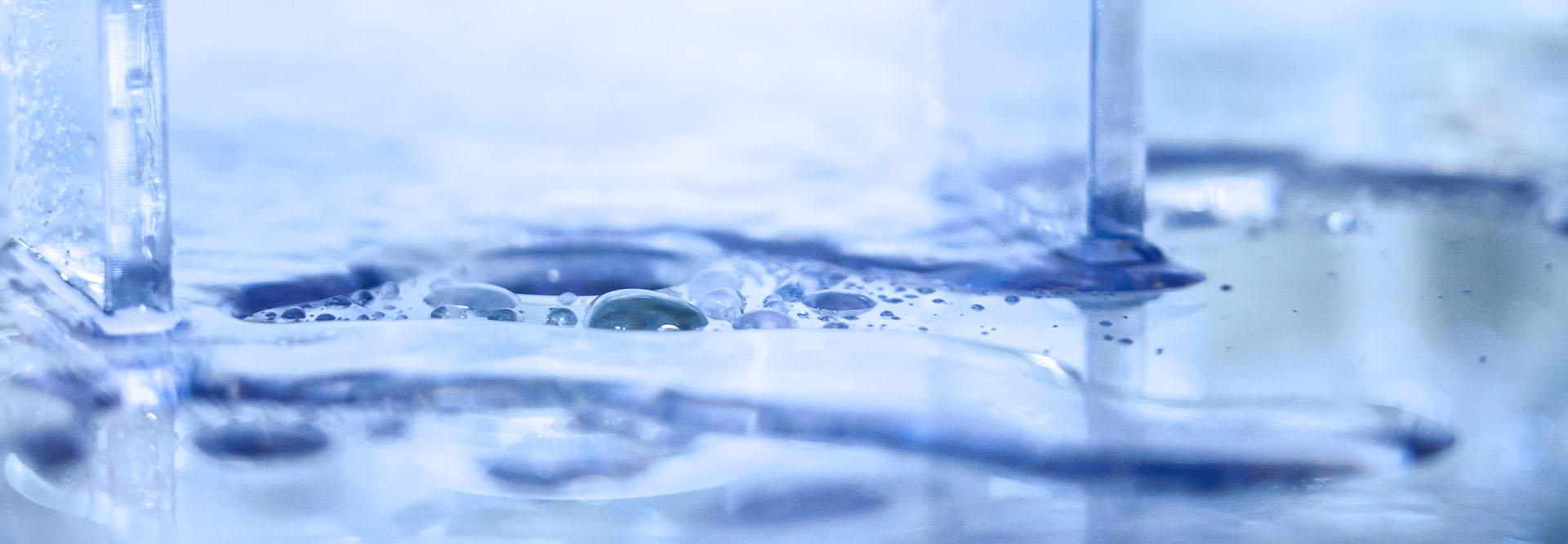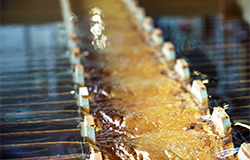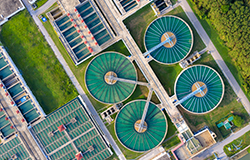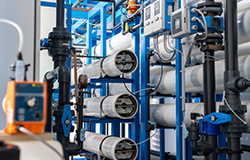Water
We are committed to tackling the challenges of water scarcity and wastewater treatment across our operations.
A-
for CDP water security
42%
of water recycled and reused
10%
water efficiency improvement vs 2016
Water is essential to people, life, and business. Population growth and climate change make it increasingly important to protect this shared natural resource. We implement solutions to reduce water extraction and consumption and work closely with local stakeholders, institutions, and political representatives in the communities where we operate.
Tackling the numerous challenges of water supply has been part of our strategy since 1993 and becomes more important year after year. Our comprehensive management approach includes water stress assessments, conservation programs, water efficiency, and wastewater treatment. 3-3303-1
Strengthening our efforts
We recognize our responsibility for water-related challenges wherever we operate and continue to strengthen our efforts to address them. We aim to minimize our water footprint through careful management, prioritizing water efficiency wherever possible. We carefully monitor water-related risks on a double materiality basis, examining both our external impacts and the impact of external factors on our Company. We collaborate externally to promote effective water management considering a broad range of stakeholders.

Our water strategy
Our global water policy is available at www.st.com. It reflects our commitment and approach to managing water within our operations and supply chain. The policy is based on four key principles:
- demonstrating water conservation leadership
- managing water risks and opportunities
- enabling solutions for the world
- engaging with stakeholders
It is our ambition to increase the water resilience of our sites and implement mitigation strategies to minimize risks related to water availability and biodiversity. This process includes reviewing our energy supply to select the most water-efficient energy sources.
We aim to minimize any impact from our operations on local communities through careful management and committed partnerships; and create value by providing responsible products and technologies. Our long-term goal is to implement solutions that protect water resources and deliver long-term societal value, especially in water-stressed areas.
Our corporate water program is responsible for creating a water roadmap for our front- and back-end manufacturing sites, with dedicated water champions to help implement actions locally.
Collaborative approach
We recognize the importance of external partnerships and collaborations to grow and share knowledge. In 2023, ST joined the Alliance for Water Stewardship (AWS), which provides a globally recognized best practice framework to guide water management at sites using water. This partnership will help us identify common challenges and build knowledge to effectively drive our water management strategies. Going forward, we plan to work towards AWS certification of our sites to further demonstrate our commitment to water stewardship.
In October 2023, we attended the Ultrapure Micro Annual Conference in Texas, which focuses on water treatment in the semiconductor industry. The event provided an opportunity to discover emerging technologies for water treatment and participate in workshops related to water saving strategies. Our teams presented new studies and projects, such as the wastewater treatment project at our Crolles site (France), (see below).
In line with our proactive approach, we participate in several water-related industry working groups where we share best practices and techniques for water recycling. As part of the European Semiconductor Industry Association water working group, we also collaborate with our peers on topics such as standardizing calculation methodologies.
FOCUS
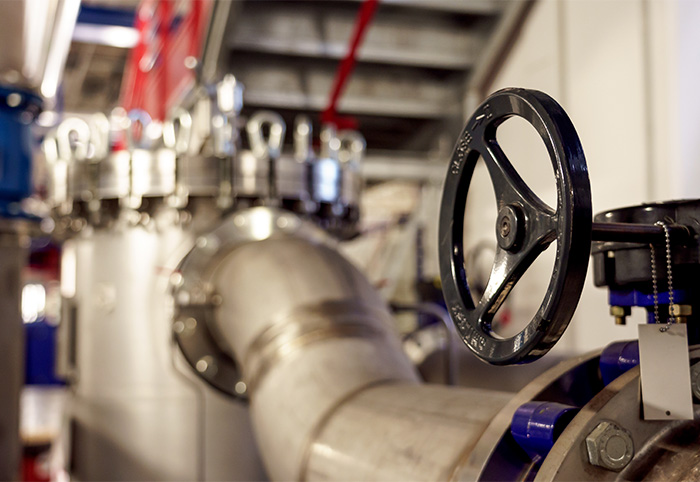
Water saving committee
Reducing water consumption is a priority across all ST operations. Recent droughts in France have led us to strengthen our efforts. In 2023, we set up a Water Saving committee in France to further oversee water management. The committee meets every two weeks and is chaired by Frédérique Le Grevès, ST's Executive Vice President Europe & France Public Affairs and President of STMicroelectronics France. It brings together all French sites and the cross-functional expertise needed to guide water saving actions in the short and medium term.
The main objectives of the committee are to drive and coordinate programs and initiatives for reducing water consumption and recycling. Seasonal risks, such as a lack of water in the summer, are also taken into consideration. The committee takes a proactive approach to responding to French government regulations, including the ‘Action plan for concerted and resilient water management’ policy introduced in March 2023.
With the support of the Water Saving committee, each front-end manufacturing site is responsible for creating its own roadmap according to the local context. Examples of actions taken so far include:
- a new six-step methodology for water saving
- increased monitoring
- recalibrating machinery for optimal performance
- appointing water champions at each site
Going forward, the committee will continue to support water management and work with local teams to identify innovative solutions to save water.
Recognized by CDP
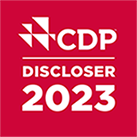
We have been participating in CDP’s annual water security survey since 2011. Preparing our submission helps us identify areas for improvement and provides a platform for our customers to assess our water performance. In 2023, we received an A- score for CDP water security, placing us in the ‘leadership’ band. This is higher than the Europe regional average of C, and higher than the electrical and electronic equipment sector average of C. We scored highly in areas such as governance, policy, and water risk assessment and response. Going forward, we will accelerate our efforts related to value chain engagement, in line with our corporate strategy.
Assessing impact and water-related risks
Water withdrawal
A reliable water supply is essential to the semiconductor manufacturing process. All ST sites manage their water-related risks according to their needs and water availability. Each site monitors the volume of water it uses and complies with local permits. Only two of our manufacturing sites use groundwater for their operations.
In 2023, 87% of the water used throughout our operations came from municipal water supplies, with 13% coming from groundwater.
Water withdrawal(1) by source in 2023 (%) 303-3SDG 6.4
Addressing water-related risks
In 2021, we undertook a comprehensive water assessment to evaluate our global water footprint. Our primary goal was to identify areas of high-water stress and assess the water-related risks of our operations. Additionally, we aimed to evaluate our impact on local communities and ensure we were taking steps to mitigate any negative effects.
Our direct and indirect impacts were evaluated using the lifecycle assessment approach. We also identified that most of our manufacturing sites are at medium risk for operational and external risks, water quality, and water scarcity, using the Water Risk Filter 5.0 methodology.
In 2022, we went one step further, requesting our manufacturing sites to assess relevant risks and formalize water saving action plans. As a result, all sites successfully defined remedial actions. Action plans are reviewed quarterly at both manufacturing and corporate level. The results form part of each site’s sustainability scorecard that is shared with the Corporate Executive Committee quarterly.
In the context of the EU taxonomy (see EU taxonomy), in 2023, we conducted a deep review of the environmental impact assessments of our manufacturing sites to verify compliance with current legislation and identify potential areas of improvement.
Reducing our water usage
Reducing water consumption while strengthening our recycling are major challenges for our Company. Manufacturing semiconductors requires a large volume of water, and we are continually striving to improve water efficiency across our operations.
Saving water
10%
water efficiency
improvement vs 2016
In 2023, our water consumption increased per unit of production compared to 2022. This was due to an increase in the use of advanced manufacturing technologies, some of which have a higher manufacturing footprint, but the devices produced have a more positive environmental impact in their use phase.
Despite this, in 2023, we reduced our water consumption by 10% per unit of production compared to 2016. Our 2025 goal is to improve our water efficiency by 20% vs 2016. We recognize that further efforts will be necessary to meet this target and we are working towards implementing the action plans identified for each site.
Water usage varies from site to site according to local conditions, such as raw water quality, treatment technologies, and local strategies. Usage is split across four main areas:
- ultrapure water production
- cooling
- heating, ventilation, and air conditioning
- drinking water
Identifying and measuring water usage is the first step in assessing areas for improvement, such as technical upgrades or optimizing processes and tools.
Our Ang Mo Kio site (Singapore) introduced several projects to improve its water efficiency. For example, the site implemented a smart water metering system to identify consumption inefficiencies and detect leaks and water wastage. This allows for improvements and corrective actions to be defined, while enhancing the reliability of data monitoring. In line with our aim to operate efficiently and minimize resource consumption, the site is also implementing a district cooling facility. This will reduce our emissions and positively affect our water use.

Wilson Chiew
Principal Engineer, SP Group
SP Group is a key partner in ST’s carbon neutrality journey. We are deploying Singapore’s largest industrial district cooling system at ST’s Ang Mo Kio site, providing sustainable cooling to reduce energy consumption and carbon emissions. This also supports ST’s water saving efforts. We will be recovering reverse osmosis reject water, a by-product from the reverse osmosis process in semiconductor production, as part of the makeup water for the cooling tower at our district cooling plant.
At our Rousset site (France), we held a worldwide water meeting, involving the heads of the water treatment plants at all front-end sites. Although each site faces different operational, legal, and technical constraints, the objective was to discuss common challenges, exchange technical know-how, and share best practices. As a result, our front-end manufacturing sites developed their 2024 water-saving roadmap and initiated a water-saving workgroup.
Our back-end sites also pursued their efforts to improve water efficiency in 2023, with the goal of reaching an overall water recycling rate of 60% by 2026.
Our Calamba site (the Philippines), implemented a range of maintenance and improvement actions to help with water conservation. This included drainpipe replacement, drain hose segregation, and the use of recycled water for the cooling tower instead of fresh water. All the actions implemented during the year resulted in a water saving of approximatively 20% of the site’s water consumption.
Reuse and recycle
One of our main approaches to water conservation is to reuse and recycle. However, as the semiconductor production process relies on ultra-pure water, it is not always possible to reuse processed water. Although water can be treated and recycled into ultra-pure water, it is more often reused to cover facility needs, such as cooling towers, scrubbers, and thermal processing units.
At our Greater Noida site (India), rainwater harvesting pits are used to collect water from building roof tops, paved surfaces, roads and green landscaped areas. This increases the amount of water that enters the ground water reservoir, helping to maintain natural sources.
42%
of water recycled and reused
In 2023, our water recycling rate was 42%, the same level as in 2022. We recognize that further efforts are needed to reach our goal of 50% by 2025. We have identified the sites where we need to accelerate actions to achieve our goal.
Treating wastewater
Wastewater from our manufacturing processes contains pollutants, such as heavy metals and toxic solvents. It is our responsibility to ensure all used water is appropriately treated before discharging it back into the natural environment.
To mitigate any risk of pollution, our wastewater is treated on site or in municipal treatment plants before being discharged. Our manufacturing sites are continually improving their treatment of wastewater and the quality of water discharge, which is carefully controlled and monitored online.
At our Crolles site (France), we started a pilot line to recycle part of the final aqueous discharges from the wastewater treatment plant. These can then be used in the manufacture of softened water and ultra-pure water, reducing the use of municipal water for industrial purposes. Recycling operations started in late 2023 and this process for ultra-pure water is expected to be fully qualified in the course of 2024. This first-of-a-kind project within the European semiconductor industry will allow us to recycle up to 40m3 of water per hour in 2024.
Contributing to the SDGs
Our commitments and programs described above contribute to UN Sustainable Development Goals (SDGs):
SDG target 6.4 – Substantially increase water-use efficiency across all sectors and ensure sustainable withdrawals and supply of freshwater to address water scarcity.
SDG target 8.4 – Improve progressively, through 2030, global resource efficiency in consumption and production.
2025 sustainability goal |
Status |
Comments |
SG13: Improve our water efficiency by 20% by 2025 vs 2016. |
-10% |
Annual sustainability goal |
Status |
Comments |
SG14: Recycle at least 50% of the water used each year. |
42% |


